It’s easy to create sensory bins your child will love. Sensory play allows kids to explore through their senses, to improve their vocabulary, practise their fine motor skills, and so much more. Sensory bins are an easy and versatile way to introduce this.  Not all sensory bins are created equal. While just plunking a few items in a bin will still result in your child enjoying some sensory input and play, there are ways that you can create sensory bins your child will love.
Not all sensory bins are created equal. While just plunking a few items in a bin will still result in your child enjoying some sensory input and play, there are ways that you can create sensory bins your child will love.
Those awesome tubs will encourage hours of imaginative play. They will engage multiple senses and bring out the best of their imagination.
How to create sensory bins your child will love:
Incorporate as many senses as possible.
Most sensory bins will engage the visual and tactile senses, but the more senses you can engage, the better. Consider adding auditory (sound) elements. Add smell to provide olfactory input. Place things in the bin to challenge proprioception (pressure). Or even add a taste element to the bin.
Ideas to add sound:
-
- items with crunchy textures
- jingle bells
- sound shakers
- fill a small container with seeds or beads
- bubble wrap
- sound machine
- instruments
- answer buzzers
Ideas to add smell:
- cinnamon sticks
- essential oils
- smell bottles
- baby powder
- flowers
- citrus (lemons, limes, oranges, grapefruit)
- coffee beans or grounds
- chocolate or chocolate powder
- tea or tea bags
- herbs
- grass
Ideas to add taste or oral sensory input:
- harmonica
- cooked noodles
- edible playdough
- dry cereal
- edible water beads
- ice cubes
- whipped cream
- pudding
- jello
- water
- sprinkles
- candy
- snow
Ideas to add proprioception input:
- bubble wrap
- slime
- playdough
- cloud dough
- rubber bands
- packing peanuts
Use a variety of textures.
Incorporating different textures adds to the sensory experience. When possible, try to incorporate things that are opposites, such as something hard and something soft.
Ideas for adding texture:
- paper shreds
- cotton balls or cotton batting
- ice
- rocks or pebbles
- fabric
- bubble wrap
- sandpaper
- water beads
- bricks or blocks
- jello
Consider your child’s interests and passions.
Think about the things that your child is interested in. What do they talk a lot about? What are they passionate about? Incorporate that into a sensory bin.
They can even help you plan it out. Maybe your daughter is in a huge dinosaur phase. She probably knows more about dinosaurs than you do, so have her plan out what to include. Allow her to choose the sensory bin base and what items to place inside.
Choose a theme.
It’s easy to create a sensory bin around a theme. Themes also allow for great imaginative play for kids. You can find a huge list of sensory bin theme ideas here.
Include items that can be used for scooping, pinching, and pouring.
Include cups, bowls, tweezers, tongs, spoons, measuring cups or spoons, sieves, funnels, tubes, empty toilet paper or paper towel rolls, small shovels, jars, ladles, slotted spoons, strainers, tea infuser, and bottles. These will encourage a lot of exploration as well as providing opportunity for good fine motor practise.
Make each sensory bin unique.
It’s fun for kids to discover a new sensory bin. Surprising them with a fun new theme or new sensory bin fillers keeps them interested.
Let your child play.
Sensory bins work best when you allow your child to lead. This fuels their imagination. When their play is self-directed, children learn more and better retain what they learn. Create the sensory bin (either for your child or with your child) and then sit back and watch your child play.
These may also interest you:
Check out The Mega List of Sensory Bin Fillers and Tools for lots of great ideas of what to include in your next sensory tub.
If you feel stuck on deciding what to make, this list of sensory bin themes will help get your creativity going.
